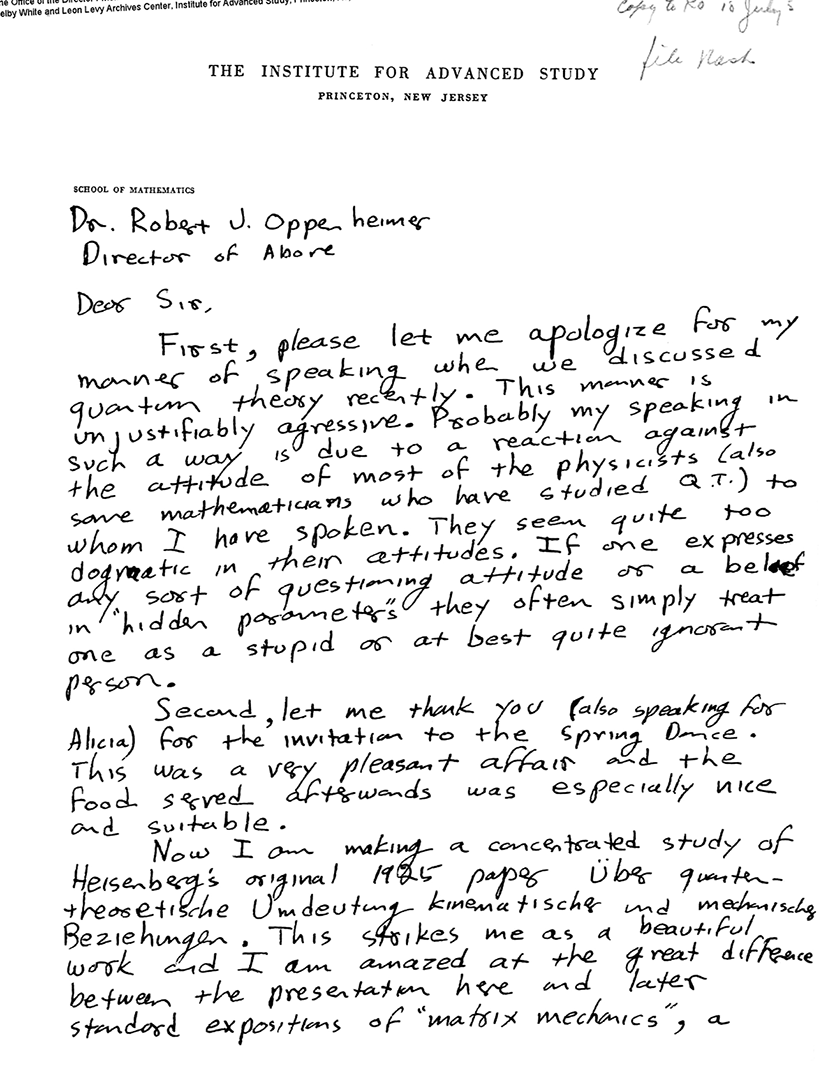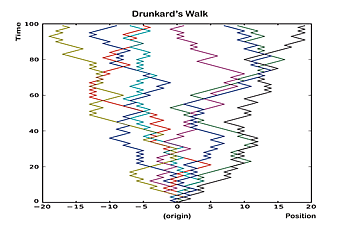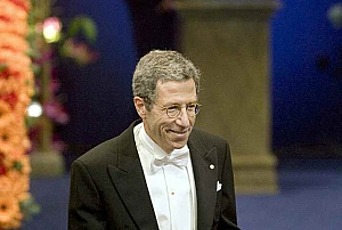John Forbes Nash, Jr., 1928–2015

On May 19, 2015, King Harald V of Norway presented the Abel Prize from the Norwegian Academy of Science and Letters to John Nash, Member (1956–57, 1961–62, 1963–64) in the School of Mathematics, and long-time member of the Princeton University Department of Mathematics, for his contributions to the theory of nonlinear partial differential equations, which are used to describe the basic laws of phenomena in physics, chemistry, biology, and other sciences. Returning to Princeton from the prize ceremony in Oslo, Nash and his wife Alicia died together in an automobile accident. “I hope one thing will become clear when we look back on Dr. John Nash’s life,” observed Robbert Dijkgraaf, Director of the Institute and Leon Levy Professor. “There are many brilliant minds, but he was a very special kind. . . . He was always going in directions that were either thought to be impossible, or actively discouraged.”
One of a handful of mathematicians known outside academia—due to the film based loosely on the biography A Beautiful Mind (Simon & Schuster, 1998) by Sylvia Nasar, written during her time as a Director’s Visitor at the Institute—Nash’s early brilliance and later acclaim were contrasted by decades of mental illness and relative obscurity. International recognition came in October 1994 when Nash, after attending an Institute seminar, had a conversation with mathematician Harold Kuhn. “As we sat on the bench, enjoying the mild fall weather and the splendor of the Institute woods, I told John that he should be up at 6:30 a.m. the following morning to receive a phone call from Carl-Olof Jacobsen, Secretary General of the Nobel Foundation, who would tell him that he was sharing the Prize in Economic Sciences in Memory of Alfred Nobel,” recalled Kuhn in the preface to The Essential John Nash (Princeton University Press, 2002). Nash married Alicia during his first visit as a Member in 1956–57. Then twenty-nine years old, he wrote the following letter (from the Institute’s Shelby White and Leon Levy Archives Center) to J. Robert Oppenheimer, the Institute’s Director from 1947–66.

Dr. Robert J. Oppenheimer
Director of Above
Dear Sir,
First, please let me apologize for my manner of speaking when we discussed quantum theory recently. This manner is unjustifiably aggressive. Probably my speaking in such a way is due to a reaction against the attitude of most of the physicists (also some mathematicians who have studied Q.T.) to whom I have spoken. They seem quite too dogmatic in their attitudes. If one expresses any sort of questioning attitude or a belief in “hidden parameters” they often simply treat one as a stupid or at best quite ignorant person.
Second, let me thank you (also speaking for Alicia) for the invitation to the Spring Dance. This was a very pleasant affair and the food served afterwards was especially nice and suitable.
Now I am making a concentrated study of Heisenberg’s original 1925 paper “Über quantentheoretische Umdeutung kinematischer und mechanischer Beziehungen.” This strikes me as a beautiful work and I am amazed at the great difference between expositions of ‘‘matrix mechanics,” a difference, which from my viewpoint, seems definitely in favor of the original.
There is general phenomenon, affecting mathematics, and physics (I am particularly familiar with the mathematics situation) of evolutionary elegantizing camouflage. A creative man will carry through a successful endeavor, perhaps developing a new theory. In original form the connections to the prior body of knowledge and the path by which he moved may still be visible or inferable (of course the whole of his preliminary work and ideas never shows). Later the theory is generalized. New notations are introduced, conceptual patterns are built up. Elegance is introduced, at the cost of clarity, if necessary. The success of the theory makes it no longer necessary to give an exposition revealing its relations to, and outgrowth from, the more primitive theory of the past. Now it can be presented as dogma.
To me one of the best things about the Heisenberg paper is its restriction to the observable quantities. I feel the current standard formulations of Q.M. have lost this quality to a considerable extent. Of course I want to find a different and more satisfying under-picture of a non-observable reality (at least non-observable directly through standard electromagnetic [atomic] interactions, which always disturb the system uncontrollably and give rise to the uncertainty principle).
In this 1925 paper Heisenberg’s theory still has the character that Bohr’s had (although more subtly) of being an adjunction of modifying rules to the classical theory of a mechanical system or atom. The drastic character of the revolution is susceptible to exaggeration. This quality also appears in subsequent formulations because of the usability of the Hamiltonian.
I want to discover why the classical picture is still latent in Q.M. to such a strong extent. Of course this is an individual matter of opinion and feeling. Only the individual himself can finally decide that he considers that he understands something.
Perhaps when I have carried my study and thinking further I will be in a better position to carry on a fruitful discussion with others who are versed on the subject.
Before closing let me thank you again for the sacrifice of your time and apologize for my annoyance. The conversations have actually been quite stimulating and helpful to me.
Sincerely yours,
John Nash
In his 1994 Nobel Prize biographical essay, John Nash introduces himself: “My beginning as a legally recognized individual occurred on June 13, 1928, in Bluefield, West Virginia . . .” His father was an electrical engineer and his mother was a school teacher before marriage. Bluefield, a small city in the Appalachians, was described by Nash as “not a community of scholars or of high technology.” As a child, he learned from reading Compton’s Pictured Encyclopedia, and by the time he was a student in high school, he was reading the classic Men of Mathematics, written by E. T. Bell in 1937. Below is an excerpt from Bell’s introduction to the volume, which Nash described as “very impressive—it gives you sort of a romantic impression of some of the mathematicians, the great minds.”
Of recent years there has been a tremendous surge of general interest in science, particularly physical science, and its bearing on our rapidly changing philosophical outlook on the universe. Numerous excellent accounts of current advances in science, written in as untechnical language as possible, have served to lessen the gap between the professional scientist and those who must make their livings at something other than science. In many of these expositions, especially those concerned with relativity and the modem quantum theory, names occur with which the general reader cannot be expected to be familiar—Gauss, Cayley, Riemann, and Hermite, for instance. With a knowledge of who these men were, their part in preparing for the explosive growth of physical science since 1900, and an appreciation of their rich personalities, the magnificent achievements of science fall into a truer perspective and take on a new significance.
The great mathematicians have played a part in the evolution of scientific and philosophic thought comparable to that of the philosophers and scientists themselves. To portray the leading features of that part through the lives of master mathematicians, presented against a background of some of the dominant problems of their times, is the purpose of the following chapters. The emphasis is wholly on modern mathematics, that is, on those great and simple guiding ideas of mathematical thought that are still of vital importance in living, creative science and mathematics.
It must not be imagined that the sole function of mathematics—“the handmaiden of the sciences”—is to serve science. Mathematics has also been called “the Queen of the Sciences.” If occasionally the Queen has seemed to beg from the sciences she has been a very proud sort of beggar, neither asking nor accepting favors from any of her more affluent sister sciences. What she gets she pays for. Mathematics has a light and wisdom of its own, above any possible application to science, and it will richly reward any intelligent human being to catch a glimpse of what mathematics means to itself. This is not the old doctrine of art for art’s sake; it is art for humanity’s sake. After all, the whole purpose of science is not technology—God knows we have gadgets enough already; science also explores depths of a universe that will never, by any stretch of the imagination, be visited by human beings or affect our material existence. So we shall attend also to some of the things which the great mathematicians have considered worthy of loving understanding for their intrinsic beauty.
Recommended Reading and Viewing:
“What John Nash Taught Us,” Robbert Dijkgraaf, Time (May 24, 2015): http://time.com/3895322/john-nash
Abel Prize committee’s short film about Nash and his work: www.abelprisen.no/artikkel/vis.html?tid=63683


